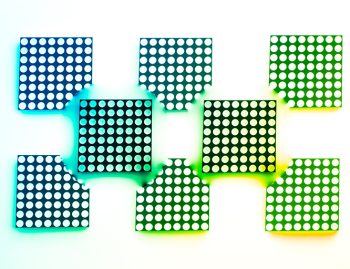
For over 25 years, light pipes have helped electrical engineers solve several common problems when designing products that communicate through LED indicators.
At the outset, the development of light pipes was a giant leap forward. Essentially, light pipes have accomplished:
- A de-coupling of the PC board with the control panel. LED components need not be positioned right at the point of indication. A light pipe can deliver the light, without crosstalk and with little loss of vibrancy anywhere on the exterior of the product, regardless of where the circuitry is mounted.
- The elimination of light bleed. Light pipes from Bivar use reflective and refractive technologies to isolate each individual LED, so there is no interference between colors. This provides unambiguous and clear light signals.
- Secure connection to the surface of casings. Precision light pipes provide more reliable durability and reduce the possibility that internal light sources get dislodged from their control panel position. Tight connections also allow products to achieve ingress protection for harsh outdoor environments and overall longer product life.
- Greater design flexibility in spatial layouts Engineers are able to free up more PC board real estate by as much as 35% by grouping all the LEDs together.
To this last point, the practice of grouping LEDs is by now quite common. The collection of board-mounted LEDs installed in a row (or array) makes for ease of assembly and as mentioned, more efficient use of space. Larger groupings usually form LEDs in rows and columns (a matrix) on the PCB.
Addressing the grouping of all the LEDs on a product is the key to greater design and manufacturing efficiency in the latest step forward in light pipe technology.
MLPS: the next evolution
The next evolution of light pipes at Bivar — as seen in its new offering, the Modular Light Pipe System (MLPS) — focuses not on individual LEDs but rather on these tightly positioned groupings, either as arrays or matrices. This innovative concept solves another set of design problems for the product developers.
The idea behind MLPS is simple. Given that so many manufacturers now choose to group their LEDs on a board, the MLPS deliverable from Bivar comes as a single part that corresponds to the size of the array or matrix. A small device might only have four indicators, (say for power, wifi connectivity, error alert, and standby mode). The customer orders through Bivar’s online configurator feature, selecting a 1 x 4 array, along with diameter style options and the lengths and shapes of rigid light pipes needed for the interface.
Quick delivery of a bezeled array or matrix can be done in small-quantity samples at low per-unit cost, ideal for prototype testing. Similarly, engineering teams can order much larger quantities ready for the production line through the same convenient online system.
In both cases, the light pipes come out of the package pre-assembled in a precision alignment bezel. This consists of a single framework that can be simply pressed into a circuit board as a unit, greatly speeding up the assembly process. Our example 1 x 4 configuration holds the four custom-length light pipes, ready to fit perfectly into the user interface.
Bypassing subcontracted parts
Besides low-cost prototypes, flexible sourcing of production quantities, and reduced assembly times, what other problems can MLPS solve?
Bivar’s modular light pipe system was devised to significantly reduce the lead times and related costs to procuring light pipe customization. Design teams in the past frequently encountered budget overruns and delays when obtaining custom light pipes from outside vendors.
The in-house team may have had to spend extra time developing design drawings for each specified light pipe, then more time corresponding with a fabricator to initiate and monitor the fulfillment. As with custom-order electronic parts, vendors may have backlogs of work and unpredictable lead times, contributing to higher prices and even costlier delays.
The modular in Modular Light Pipe System means that Bivar has a supply of rigid light pipes that fulfill a customer’s form-and-fit requirements readily at hand. Time-intensive and erratic subcontracting process can be wholly eliminated by adopting the MLPS.
Start building
Bivar MLPS can configure a wide range of sizes and shapes, accommodating up to 96 LEDs in an 8 x 12 matrix. Modular bezels also comport with Bivar’s wide selection of rigid light pipe products of various diameters, attachment methods, and dome options.
The new MLPS also makes it easier to change a LED matrix configuration midway during the design process, or to update to new versions of a product over time which may have greater or fewer LED features. All that is needed is a few changes in the online configurator.
Ready to evolve to the next step in light pipe procurement? Take a closer look at the new modular light pipe system.









